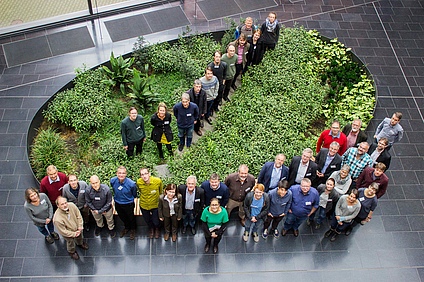Summary

On the 27th and 28th of November 2017 a total of 39 representatives of federal agencies, professional societies and scientific institutions came together in the iDiv, Leipzig, to discuss how and to what extent nation-wide data on the distribution, occurrence and/or abundance of species can be combined to investigate changes in biodiversity in space and time. We aimed at screening the datasets available to the different stakeholders and evaluate possibilities to harmonise and analyse these data. The workshop was a very inspiring and constructive experience for all participants.
The main task of this meeting was to elaborate the pivotal question on how and in which depth data can be analysed in terms of changes in species distribution, species occurrence and species abundances in space and time, that were originally not collected with the aim to do so. A major challenge that was identified during this discussion was the tremendous heterogeneity of the methods that were used to gather the respective data within and across the different stakeholders. This information is necessary if one aims at harmonising datasets to allow for a harmonisation across the available data. Here, the development of methods that allow to account for this heterogeneity when analysing the data will potentially allow assessing the past development of species numbers, distribution and/or abundances of species in Germany across space and time.
In 20 presentations (see below; German only) the representatives of the different stakeholders gave an overview on the available data and gave an insight into already existing initiatives for biodiversity monitoring in Germany.
There was a general agreement among the participants that resurveys of selected, highly interesting regions would be very promising to supplement existing information. Here, scientific institutions such as Universities may play an important role, who, in close collaboration with experts who already carried out the old surveys, will develop a harmonised protocol for data collection. This will allow to jointly analyse historical and future surveys. Calls for such resurvey initiatives might be started through the channels of the national professional and also scientific societies. This will foster the collaborative and integrative nature, which should become the basis of a national biodiversity monitoring system.
sMon may act as a catalysing interface between federal and national agencies, professional and nature conservation societies as well as scientific institutions. In this respect, sMon will assist the stakeholders in the statistical analysis of this data; develop new methods, tools and workflows to do so. Findings and insights from this extensive collaboration will be presented in a public-oriented way to the broader public, e.g. in non-scientific as well as scientific conferences, newspapers as well as ostensive graphs, maps and posters.
The participants agreed on organizing a common second small-scale workshop in the end of January 2018, where we will concentrate on the practical analysis of already existing and potential future data. Another comprehensive workshop will be carried out in late 2018 where the results of the synthesis project will be discussed, evaluated and presented to the stakeholders.
The sMon Team would like to thank all participants for an inspiring and exciting workshop. We are looking forward to a constructive collaboration!
01 sMon Team welcome note (Prof. A. Bonn, iDiv, UfZ, Univ. of Jena)
02 Monitoring und Biodiversitätserfassungsprogramme in Deutschland (Dr. A. Krüß, BfN)
03 Zentrale Artendatenbank (ZenA) Sachsens Auswertungsbeispiel von Langzeittrends (H. Lueg, LfULG)
04 Die Ökologische Flächenstichprobe in Nordrhein-Westfalen (H. König, LANUV NRW)
05 Monitoring und Biodiversitätserfassung im Saarland (Dr. S. Caspari, MfUV Saarland)
06 Überblick übder den Datenbestand in Schleswig-Holstein (Dr. S. Lütt, LLUR Schleswig-Holstein)
07 Monitoring und Biodiversitätserfassung in Hessen (C. geske, HLNUG Hessen)
08 Monitoring und Biodiversitätserfassung in Sachsen-Anhalt (Dr. D. Frank, LAU Sachsen-Anhalt)
09 Biotopkataster Hamburg (Dr. K. Kreft, BUE Hamburg)
10 Grünlandmonitoring in Bayern (Dr. G. Kuhn, LfL Bayern)
11 Überblick zum Datenbestand in Mecklenburg-Vorpommern (Prof. F. Jansen, Uni Rostock)
12 Überblick zum datenbestand in Thüringen (Dr. M. Musche, TLUG Thüringen, UfZ, iDiv)
16 Datenlage der Amphibien in Deutschland (Dr. U. Schulte, DGHT)
18 Verbreitungsatlas der Libellen Deutschlands (K-J. Conze, Dr. M. Lohr, T. Rautenberg, GdO)
20 Ergebnisse des BioChange-Projektes (Prof. K. Wesche, Senckenberg Görlitz)
